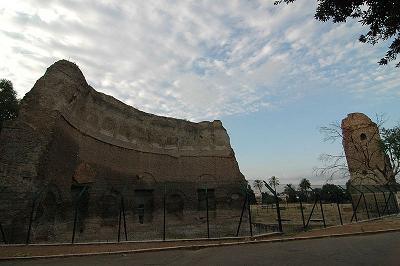History: The Baths of Trajan were a massive thermae, a bathing and leisure complex, built in ancient Rome starting from 104 AD and dedicated during the Kalends of July in 109. Commissioned by Emperor Trajan, the complex of baths occupied space on the southern side of the Oppian Hill on the outskirts of what was then the main developed area of the city, although still inside the boundary of the Servian Wall. The architect of the complex is said to be Apollodorus of Damascus. After being utilized mainly as a recreational and social center by Roman citizens, both men and women, for many years, the baths, in use as late as the early fifth century[1] seem to have been deserted at the time of the siege of Rome by the Goths in 537; with the destruction of the Roman aqueducts, the thermae were abandoned, as was the whole of the now-waterless Mons Oppius.
prior to the construction of the Baths, their location on the Oppian Hill was occupied by the ornatePalaceofNero(Domus Aurea). After Nero’s suicide, subsequent emperors Vespasian, Titus, and Domitian chose to build over his palace with other forms of architecture. Emperor Trajan covered up the last of the palace with a platform upon which the Baths were built. Because they served as a model for bath complexes built throughout the Roman world during the Imperial period, these Baths would come to be recognized as a highly notable example of early Imperial Roman architecture.
Plan of the Baths of Trajan. Notice the northeast-southwest orientation.The baths were erected on the Oppian Hill, a southern extension of the Esquiline Hill. Built on a platform that had itself been built over Nero’s Palace, the bath complex was immense by ancient Roman standards, covering an area of approximately 330 by215 meters. The complex rested on a northeast-southwest axis, with the main building attached to the northeast wall. This was contrary to the more widely used north-south axis of many buildings in the vicinity. It is suggested that this unorthodox orientation was chosen by the architects to reduce the bathers’ exposure to the wind, while also maximizing exposure to the sun.
Within the complex, the building was surrounded by a large grassy area. The baths themselves consisted of pools, including a tepidarium (warm area and, it is presumed, first room visited in the baths), a caldarium (hot pool and dry, sauna-like area), frigidarium (cool pools used after those previously mentioned), and also gymnasia, and apodyteria (changing rooms). In addition to the facilities of the bath complex used by the public, there was a system of subterranean passageways and structures used by slaves and workers to service and maintain the facilities. Also underground, the massive cistern, surviving today as the Sette sale, the “seven rooms”, stored much of the water used in the baths. It was capable of storing no less than 8 million liters. There were also several exedrae on the eastern and western sides of the building. After archaeological analysis performed after excavation in 1997, it is thought that at least one of these exedra served as a sort of library and a holding place for scrolls and manuscripts.


